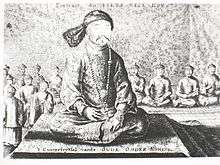Viceroys in China

Zongdu (Tsung-tu; simplified Chinese: 总督; traditional Chinese: 總督; pinyin: Zǒngdū; Wade–Giles: Tsung3-tu1; Manchu: ![]() Uheri kadalara amban), usually translated as Viceroy or Governor-General, governed one or more provinces of Qing dynasty China. One of the most important was the Viceroy of Zhili (Chihli), since it encompassed the imperial capital. Yuan Shikai, later president of the Republic of China, held this office. The title was first used use during the Ming dynasty (1368–1644).
Uheri kadalara amban), usually translated as Viceroy or Governor-General, governed one or more provinces of Qing dynasty China. One of the most important was the Viceroy of Zhili (Chihli), since it encompassed the imperial capital. Yuan Shikai, later president of the Republic of China, held this office. The title was first used use during the Ming dynasty (1368–1644).
The regional viceroys during the Qing dynasty were:
- Viceroy of Zhili
- Viceroy of Liangjiang: Jiangsu, Jiangxi, Anhui
- Viceroy of Min-Zhe: Fujian, Zhejiang, Taiwan
- Viceroy of Huguang: Hunan, Hubei
- Viceroy of Shaan-Gan: Shaanxi, Gansu, Xinjiang
- Viceroy of Liangguang: Guangdong, Guangxi
- Viceroy of Yun-Gui: Yunnan, Guizhou
- Viceroy of Sichuan
- Viceroy of the Three Northeast Provinces: Fengtian, Jilin, Heilongjiang
Chinese historians often rank the Viceroy of Zhili as the most honorable and powerful, and the Viceroy of Liangjiang as the richest of the eight. Certain provinces were not governed by any regional viceroys. These included the provinces of Shanxi, Shangdong and Henan.
Besides the regional viceroys, there were also special types of viceroys, such as Viceroy of Southern Rivers and Viceroy of Eastern Rivers, who were in charge of waterways.
References
Further reading
- Mayers, William Frederick. The Chinese Government: A Manual of Chinese Titles, Categorically Arranged and Explained, with an Appendix. 3rd edition revised by G.M.H. Playfair ed. Shanghai: Kelly & Walsh, 1897; reprint, Taibei: Ch'eng-Wen Pub. Co., 1966.